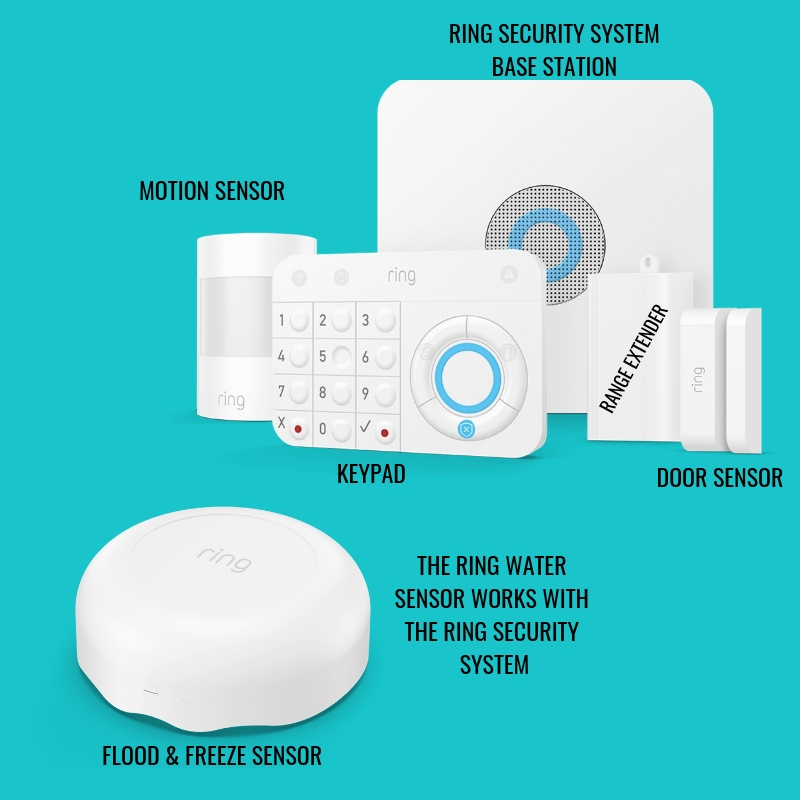Ring Water Sensor Review
/Ring Water Sensor Review
We got a chance to see the new Ring Water Sensor at CES and are excited that Ring is adding the water sensor to their smart home security system. Ring first launched their smart alarm system in 2018 and it has been a hit ever since.
I personally installed a Ring Security System in my home because of the system’s great value in comparison to competing products and full line of features it offers for a home security system. You can use the system without a monthly subscription cost or upgrade the system to full professional monitoring for only $10 per month. On top of that you can even arm or disarm your ring security system using Alexa.
Ring has also just added compatibility with a Smart Alarm Siren, Smart Smoke Detector and Smoke Detector Sound Sensor that work with the Ring Security System in addition to the standard motion and door sensors that work with the Ring Security System
Related Post: How To Connect Ring Security System To Alexa
Ring Water Sensor Review: The Ring Water Sensor Works With The Ring Security System
Ring Water Sensor Review: What can it do?
The Ring Water Sensor is actually both a water sensor that will detect water leaks and it can can also alert you if the temperature inside your home drops below 40 degrees to prevent freezing pipe. It’s two in one functionality offers a lot in a small package. The Ring Water Sensor connects to the Ring Security system and works with the Ring App. Once you have the Ring Security System setup you can connect the water sensors as needed to monitor locations around your home for water.
Related Post: Ring Security System Review
Ring Water Sensor Review: Where Should You Place It?
Early detection of water with your Ring Water Sensor can save you hours of headaches and prevent thousands of dollars in damage inside your home. But where should you place the Ring Water Sensor to provide the most protection for your home? We cover the most common culprits of water damage and where to place your Ring Water Sensor to prevent water damage
Related Post: New Ring Door View Smart Doorbell Review
1. Where To Place Your Ring Water Sensor: Near Your Sump Pump
Sump pump failure is one of the most common causes of water damage and most of the time when it happens your asleep after a big storm or at work and there is nothing you can do to prevent it. We had a smart home client who’s sump pump failed immediately after purchasing a house and the first time he visited his new home he was surprised with 5 inches of standing water in his fully finished basement, that’s not the kind of new home gift anyone wants.
Placing a your Ring Water Sensor next to your sump pump or or just below the top edge of the sump pump basin or on top of your sump pump cover is a great way to be notified of the potential for water damage before it’s too late. If your sump pump starts to overflow it’s a good idea to quickly spring into action. You should check first to see if there is an easy fix like resetting your breaker but if that doesn’t fix the issue having a shop vac handy can help slow down the water infiltration. If you can’t get a plumber to your house immediately its a good idea to pick up a pump and connect it to a nearby drain before the problem gets worse.
Utilizing a battery backup kit with your sump pump can also reduce the potential for sump pump failure in the event of a power option.
If you have a finished basement we recommend not only a water sensor but placing a streaming smart camera viewing your sump pump so you can check in on those super rainy days. Ring, Nest & Amazon all make reliable streaming cameras that can be used to monitor you sump pump.
2. Where To Place Your Ring Water Sensor: Near Your Water Heater
Water heaters are notorious for failing at the worst time possible. Not only can you be left taking a cold shower but your home can be flooded from a water heater failure When you combine fire, water and heat bad things happen over time, like corrosion build up, scale and worn out gaskets. Corrosion failure of water heaters is one of the most common ways that a water heater can fail. Placing a Ring Water Sensor in the water heater pan or near the water heater is a a great way to catch leaks before they become floods.
It’s always a good idea to visually inspect your water heater for leaks every 6 months. The most common areas for water heater leaks are right at the top of the water heater where the inbound and outbound water supply are connected. Tank failure also can happen on older water heaters where the tank or seals begin to leak causing water to drain from the bottom of the tank.
3. Where to Place Your Ring Water Sensor: HVAC System
Why would you need to put a Ring Flood Freeze Sensor near your HVAC system? Because your HVAC system can leak. You might not think that a HVAC system or furnace can leak but it is often one for the more problematic home appliances for water damage. HVAC systems that have air conditioning attached will generate condensation from cooling down the air. Typically this condensation flows from HVAC unit right into a small condensate drain typically located near your HVAC system. But this small drain piping is typically small white PVC piping and because it is so small it can be prone to clogging. When this happens all the sudden you can find yourself with a leaky HVAC system and water damage.
To prevent the condensate drain from clogging you should visually inspect it once a month when your HVAC is running to make sure you it’s running free and clear. You should also change your HVAC furnace filters every 6 months or whenever you are painting or doing renovation work to prevent dust from accumulating inside your HVAC system.
Related Post: Nest vs Ecobee Smart Thermostat
If you have a built in whole home humidifier on your HVAC system it can also be a source of leaks and potential water damage to your home. It also uses small diameter piping to carry away the excess water from the humidifier to the drain. Humidifiers are notorious for building up scale inside the humidifier which can cause poor air quality and clog the humidifier drain lines. You should inspect your humidifier pad once a year and change when scale has built up.
4. Where to place your Ring Water Sensor: Plumbing In Exterior Walls or Cold Spots
If you live in part of the country that gets cold you know that freezing pipes are a major source of water damage and you probably know someone who’s pipes have frozen. Frozen pipes cause major water damage when they thaw back out and can unload thousands of gallons of water in a short time. You can use a Ring Water Sensor which also has a built in freeze sensor. It will alert you if the temperature dips below 40 degrees anywhere you place it. Making it a great option to place near piping that may run through unheated or under heated areas of your home like your basement.
Another great place to place a Ring Water / Freeze Sensor is near plumbing piping routed in exterior walls, piping that is routed in an exterior wall is can be prone to freezing and should be monitored during cold snaps. Many people have kitchen sinks that fall into this category with piping routed in an exterior wall. Placing a Ring Freeze Sensor in the cabinet where your piping is located near where the pipe come in to the cabinet is great way to keep tabs on the temperatures of your exterior piping.
5. Where to place your Ring Water Sensor: Washing Machine / Laundry Room
Washing machine basins can leak, over flow or the hoses connecting your washing machine can wear out over time causing the potential for leaks. Most newer homes have drains located near the washing machines to prevent an all out flood but this is not the case for every home. Placing a Ring Water Sensor placed near your washing machine can help you catch a leak before it turns into a bigger problem.
Ring Water Sensor Review: Features
The Ring Alarm Flood & Freeze sensor can detect both water or alert you when the temperature drops below 40 degrees to prevent frozen pipes. The Ring Alarm Flood & Freeze sensors are completely wireless and operate on a 3V battery. The batteries are projected to last 3 years with normal use. The sensors have a 250 FT communication range with with the Ring Security System base station. The sensor requires that the Ring Security Sensor base station setup and operational in order to work. The Ring Water Sensors will not work independently of the basestation and are part of a comprehensive smart home security system.
Ring Flood And Freeze Sensor Review
Ring Water Sensor Review: Summary
Our Rating: 8.00/10.00
The Ring Water Sensors are a great addition to your Smart Security System and help you provide comprehensive protection for you home. The small investment in a Ring Water Sensor can save you big dollars in the long run by helping you catch small leaks before they become floods. Water damage isn’t just unpleasant but it can lead to mold growth which can cause serious issues within your home.
The Ring Flood And Freeze Sensor is reliable and works quickly to alert your security system when water touches the bottom side of the sensor. The notification pops up on your phone and alerts you that you have a leak, and will work regardless if you are in your home or at work.











